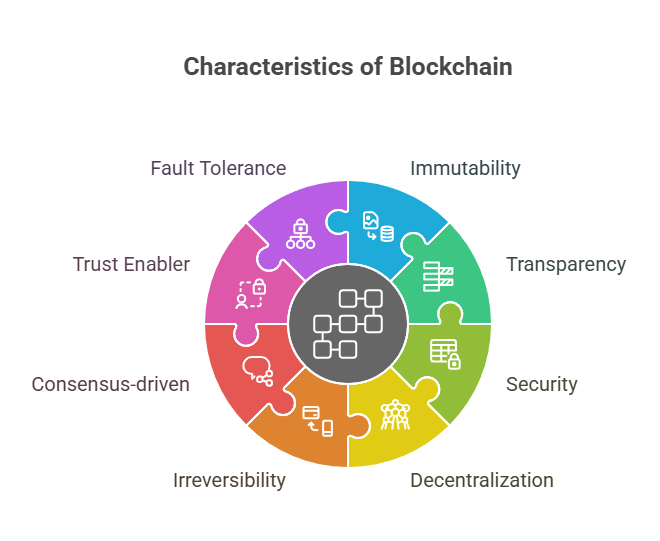Understand the defining characteristics of blockchain technology, including its distributed, tamper-proof nature. Learn the core concepts that power this revolutionary ledger, from cryptographic hashing to consensus.
At its core, blockchain technology is a distributed ledger made up of blocks. It is predicated on ideas from cryptography and distributed systems. It is often designed and utilized as a distributed platform, while it is theoretically possible for it to be either central or decentralized.
Blockchain Core Concepts
The following fundamental ideas support the operation of a blockchain:
Distributed Ledger Technology (DLT): One kind of DLT is a blockchain. This indicates that the ledger a record of events or transactions is shared and copied among several network nodes rather than being kept in a single, central place. A copy of the ledger may be owned by each network member (node).
Block Chaining: Blocks are used to organize transactions or information. Block data, usually a collection of verified transactions, and a block header are included in every block. Metadata like a timestamp, version number, nonce, and Merkle root are all contained in the block header. Importantly, a cryptographic connection to the header of the preceding block is also included in each block header. A hash function in cryptography is used to create this connection. The chain begins with the genesis block. A chain of blocks is produced by joining blocks together.
Transactions: Events, including the transfer of assets, are documented in transactions. Usually, the block data contains this type of material. The sender uses their linked private key to digitally sign transactions. Anyone with the relevant public key can validate this signature.
Cryptography: One of the core components of blockchain development and a key component of its technological underpinnings is cryptography. Digital signatures, hash functions, and asymmetric-key cryptography (public/private keys) are examples of important cryptographic primitives.
- From an input of arbitrary size, hash functions provide a fixed-length output (hash digest). The hash is drastically changed by even a little change in the input. Chaining blocks and establishing the Merkle root need hashing, which also verifies data integrity.
- Secret private keys are used for signing, whereas public keys are revealed for verification. Decentralized identity management and security need asymmetric cryptography.
- Digital signatures offer non-repudiation and data origin authentication. They demonstrate that the owner of the related private key was the source of the transaction.
- A Merkle tree is produced by periodically hashing and mixing data (such as transactions) until it is represented by a single root hash, or Merkle root. This allows efficient transaction verification using only the Merkle root.
Decentralization: This indicates that the network is not governed by a single point of failure or a central authority. Participants in the network share authority and control.
Consensus Mechanisms: A procedure is required in a decentralized system with numerous participants (nodes) in order for them to concur on the ledger’s current state and the legitimacy of fresh transactions or blocks. Consensus algorithms offer guidelines for block validation in the absence of a centralized authority. Byzantine Fault Tolerance (BFT)-based systems, Proof of Work (PoW), and Proof of Stake (PoS) are a few examples.
Smart Contracts: These are blockchain-based applications or code. When specific criteria are satisfied, they automate the execution of business logic or agreements that are triggered by the provisions of an agreement. Solidity is one of the languages in which they may be written.
Characteristics of Blockchain
These fundamental ideas come together to provide blockchain technology with a number of important features:

- Immutability: A block becomes permanent and impenetrable once it is joined to the chain and enough more blocks are placed after that. As the chain lengthens, altering older blocks becomes computationally challenging or expensive (tamper resistant), but changes made to new blocks are easily identifiable (tamper obvious) because to the cryptographic linkages between them.
- Transparency: The ledger in public blockchains is an open file that everyone may view. Independent audits and transaction visibility are made possible by this (although other blockchains include privacy options). This openness contributes to the development of trust.
- Security: By combining consensus techniques and cryptographic primitives, blockchain is made to be safe. Consensus guards against malevolent actors attempting to change the ledger, while cryptography guarantees data integrity and transaction validity.
- Decentralized Decentralization is a fundamental idea that also leads to the trait of not being governed by a single organization, which lessens dependency on conventional middlemen. Resilience is increased by networked data copies.
- Irreversible: It is very hard to undo transactions once they have been verified and included to a block that is a part of an expanding chain.
- Consensus-driven: Instead than depending on a centralized authority, the network functions on consensus among its members.
- Trust Enabler: Blockchain makes it possible for systems to be trusted, especially in decentralized settings where people might not directly trust one another. The consensus process and the record’s verifiable and unchangeable character foster trust. Relationships without trust are made feasible.
- Fault Tolerant/Resilient: The system can function well even in the event that some nodes malfunction or behave maliciously because of its distributed architecture and consensus processes, particularly BFT variations. Blockchain technology is intended to avoid problems such as the double-spending issue, which occurs when digital assets are spent more than once.
Together, these fundamental ideas and traits characterize blockchain technology and set it apart from conventional centralized database systems.
You can read The History And Evolution Of Blockchain Technology
